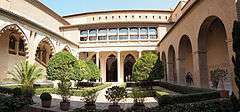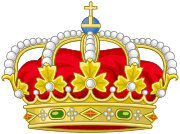Aljafería


The Aljafería Palace (Spanish: Palacio de la Aljafería; Arabic: قصر الجعفرية, tr. Qasr al-Jaʿfariya) is a fortified medieval Islamic palace built during the second half of the 11th century in the Taifa of Zaragoza of Al-Andalus, present day Zaragoza, Spain. It was the residence of the Banu Hud dynasty during the era of Abu Jaffar Al-Muqtadir after abolishing Banu Tujibi of Kindah dynasty. The palace reflects the splendor attained by the kingdom of the taifa of Zaragoza at the height of its grandeur. The palace currently contains the Cortes (regional parliament) of the autonomous community of Aragon.
The structure holds unique importance in that it is the only conserved testimony of a large building of Spanish Islamic architecture of the era of the Taifas (independent kingdoms).
History
After the reconquest of Zaragoza in 1118 by Alfonso I the Battler became the residence of the Christian kings of Aragon, which the Aljafería became the main focus of the Aragonese Mudejar diffuser. It was used as a royal residence by Pedro IV Ceremonious and later, on the main floor, was carried out the reform that turned these stays in the palace of the Catholic Monarchs in 1492. In 1593 he underwent another reform that would make military fortress, first according to Renaissance designs (which today can be seen in their surroundings, pit and gardens) and later as quartering of military regiments. It underwent continuous reforms and major damage, especially with Sites of Saragossa of the War of Independence until finally it was restored in the second half of the twentieth century and currently houses the Parliament of Aragon.
Originally the building was outside the walls of the Roman wall, on the plain of Saria or place where Muslims developed military fanfare known as La Almozara. With the urban expansion through the years, the building has remained within the city. It has been respected around a small garden setting
Troubadour Tower
.jpg)
The oldest construction of the Aljafería is called Troubadour Tower. The tower received this name from Antonio Garcia Gutierrez’s 1836 romantic drama The Troubadour. The drama was converted into a libretto for Giuseppe Verdi’s opera Il trovatore in 1853.
The tower is a defensive structure, with a quadrangular base and five levels which date back to the end of the 9th century AD, in the period governed by the first Banu Tujibi, Muhammad Alanqur, who was named after Muhammad I of Córdoba, independent Emir of Cordoba. According to Cabañero Subiza (1998) the Tower was built in the second half of the 10th century.[1] In its lower part, the tower contains vestiges of the beginning of the heavy walls of alabaster ashlar bond masonry, and continues upwards with plank lining of simple plaster and lime concrete, which is a thinner substance for reaching greater heights. The exterior does not reflect the division of the five internal floors and appears as an enormous prism, broken by narrow embrasures. Access to the interior was gained through a small door at such height that it was only possible to enter by means of a portable ladder. Its initial function was, by all indications, military.
The first level conserves the building structure of the 9th century and shelters two separated naves and six sections, which are separated by means of two cruciform pillars and divided by lowered horseshoe arcs. In spite of its simplicity, they form a balanced space and could be used as baths.
The second floor repeats the same spatial scheme as the previous floor, and the remains of Muslim brick-work from the 11th century can be seen in the brick façades, which indicates that the second floor was possibly reconstructed at the same time as the palace during the epoch of Al-Muqtadir.
Footnotes
- ↑ Cabañero Subiza (1998), p. 84.
References
- BORRÁS GUALIS, Gonzalo (1991). "La ciudad islámica". Guillermo Fatás (dir.) Guía histórico-artística de Zaragoza. Zaragoza City Council. pp. 71–100. 3rd ed. ISBN 978-84-86807-76-4
- BIEL IBÁÑEZ, María Pilar (2008). "Nuevas noticias sobre el palacio de la Aljafería". Guillermo Fatás (dir.) Guía histórico-artística de Zaragoza. Zaragoza City Council. pp. 711–727. 4th ed. ISBN 978-84-7820-948-4.
- CABAÑERO SUBIZA, Bernabé et al. (1998), La Aljafería. I. Zaragoza: Cortes de Aragón. 1998. ISBN 978-84-86794-97-2
- EXPÓSITO SEBASTIÁN et al. (2006). La Aljafería de Zaragoza. Zaragoza: Cortes de Aragón. 2006 (6ª ed.) ISBN 978-84-86794-13-2
External links
| Wikimedia Commons has media related to Palacio de la Aljafería (Zaragoza). |
- Aljafería Palace in Museum with no frontiers
- Virtual Visit to the Aljafería Palace
- Al-Andalus: the art of Islamic Spain, an exhibition catalog from The Metropolitan Museum of Art (fully available online as PDF), which contains material on Aljafería (see index)
Coordinates: 41°39′23.3″N 0°53′48.3″W / 41.656472°N 0.896750°W
